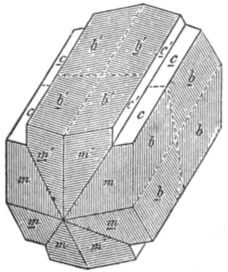| Harmotome | |
|---|---|
 | |
| General | |
| Category | zeolites |
| Formula (repeating unit) | (Ba0.5,Ca0.5,Na,K)5Al5,Si11O32·12(H2O) |
| IMA symbol | Hrm |
| Crystal system | Monoclinic |
| Crystal class | Prismatic (2/m) (same H-M symbol) |
| Space group | P21/m |
| Identification | |
| Specific gravity | 2.44 to 2.5 |
Harmotome is a mineral, one of the rarer zeolites; a hydrated barium silicate with formula: (Ba0.5,Ca0.5,Na,K)5Al5,Si11O32·12(H2O). It forms vitreous white well defined monoclinic crystals, often associated with calcite and other zeolites. It has a Mohs hardness of 4 to 5 and a specific gravity of 2.44 to 2.5.
Name and discovery
Named from the Greek words Ancient Greek: ἁρμός, romanized: harmos (a joint) and Ancient Greek: τέμνειν, romanized: témnein (to cut) by René Just Haüy in 1801 because the pyramid divides parallel to the plane that passes through the terminal edges. It was first described in 1801 from an occurrence in the Harz Mountains, Lower Saxony, Germany.
Location
Like other zeolites, harmotome occurs with calcite in the amygdaloidal cavities of volcanic rocks, for example, in the dolerites of Dumbartonshire, and as fine crystals in the agate-lined cavities in the melaphyre of Oberstein in Germany. It also occurs in gneiss, and sometimes in metalliferous veins. At Sankt Andreasberg in the Harz it is found in the lead and silver veins; and at Strontian in Argyll in lead veins, associated with brewsterite (a strontium and barium zeolite), barytes and calcite.
References
- Warr, L.N. (2021). "IMA–CNMNC approved mineral symbols". Mineralogical Magazine. 85 (3): 291–320. Bibcode:2021MinM...85..291W. doi:10.1180/mgm.2021.43. S2CID 235729616.
- ^
 One or more of the preceding sentences incorporates text from a publication now in the public domain: Spencer, Leonard James (1911). "Harmotome". In Chisholm, Hugh (ed.). Encyclopædia Britannica. Vol. 13 (11th ed.). Cambridge University Press. p. 10.
One or more of the preceding sentences incorporates text from a publication now in the public domain: Spencer, Leonard James (1911). "Harmotome". In Chisholm, Hugh (ed.). Encyclopædia Britannica. Vol. 13 (11th ed.). Cambridge University Press. p. 10.

This article about a specific silicate mineral is a stub. You can help Misplaced Pages by expanding it. |